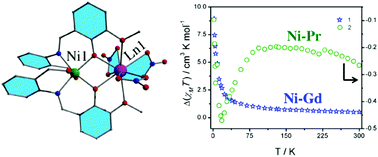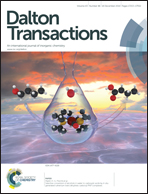Probing the magnetic and magnetothermal properties of M(ii)–Ln(iii) complexes (where M(ii) = Ni or Zn; Ln(iii) = La or Pr or Gd)†
Abstract
We establish the coordination potential of the Schiff base ligand (2-methoxy-6-[(E)-2′-hydroxymethyl-phenyliminomethyl]-phenolate (H2L)) via the isolation of various M(II)–Ln(III) complexes (where M(II) = Ni or Zn and Ln(III) = La or Pr or Gd). Single crystals of these five complexes were isolated and their solid state structures were determined by single crystal X-ray diffraction. Structural determination revealed molecular formulae of [NiGd(HL)2(NO3)3] (1), [NiPr(HL)2(NO3)3] (2) and [Ni2La(HL)4(NO3)](NO3)2 (3), [Zn2Gd(HL)4(NO3)](NO3)2 (4), and [Zn2Pr(HL)4(NO3)](NO3)2 (5). Complexes 1 and 2 were found to be neutral heterometallic dinuclear compounds, whereas 3–5 were found to be linear heterometallic trinuclear cationic complexes. Direct current (dc) magnetic susceptibility and magnetization measurements conclusively revealed that complexes 1 and 4 possess a spin ground state of S = 9/2 and 7/2 respectively. Empirically calculated ΔχMT derived from the variable temperature susceptibility data for all complexes undoubtedly indicates that the Ni(II) ion is coupled ferromagnetically with the Gd(III) ion, and antiferromagnetically with the Pr(III) ion in 1 and 2 respectively. The extent of the exchange interaction for 1 was estimated by fitting the magnetic susceptibility data using the parameters (g = 2.028, S = 9/2, J = 1.31 cm−1 and zJ = +0.007), supporting the phenomenon observed in an empirical approach. Similarly using a HDVV Hamiltonian, the magnetic data of 3 and 4 were fitted, yielding parameters g = 2.177, D = 3.133 cm−1, J = −0.978 cm−1, (for 3) and g = 1.985, D = 0.508 cm−1 (for 4). The maximum change in magnetic entropy (−ΔSm) estimated from the isothermal magnetization data for 1 was found to be 5.7 J kg−1 K−1 (ΔB = 7 Tesla) at 7.0 K, which is larger than the −ΔSm value extracted from 4 of 3.5 J kg−1 K−1 (ΔB = 7 Tesla) at 15.8 K, revealing the importance of the exchange interaction in increasing the overall ground state of a molecule for better MCE efficiency.


 Please wait while we load your content...
Please wait while we load your content...